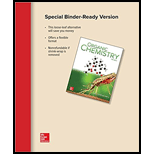
Concept explainers
(a)
Interpretation: The axial or equatorial substituents on the rings of the given structure A are to be labeled.
Concept introduction: The different spatial arrangements of atoms that results from the rotation about single bonds are called conformational isomers. The chair conformation of cyclohexane consists of six axial and six equatorial bonds.
The six axial bonds present one on each carbon atom, are parallel and alternate to each other and are in up-down position.
The six equatorial bonds present one on each carbon atom, are present in three sets of two parallel ring bonds. They are in alternate position between the sides around the ring.
(b)
Interpretation: The skeletal structure of A with the help of wedges and dashed wedges is to be drawn in order to show whether the substituents are located above or below the rings.
Concept introduction: The different spatial arrangements of atoms that results from the rotation about single bonds are called conformational isomers. When two substituents in a conformation are in up or down direction then it is known as cis conformation. But if one substituent is in upward direction and the other is facing down direction, then the conformation is known as trans.
Want to see the full answer?
Check out a sample textbook solution
Chapter 4 Solutions
ORGANIC CHEMISTRY(LL)-W/ACCESS >CUSTOM<
- a.) Draw B as a hexagon with wedges and dashed wedges to show the stereochemistry of substituents.b.) Draw a stereoisomer of A as a hexagon using wedges and dashed wedges to show the orientation of substituents.arrow_forwarda model of cyclohexane in a chair conformation, and explain why the names “axial” and“equatorial’ are appropriate.arrow_forwardIdentify circle the alkanelike portions of the following molecules: a. b. c. d.arrow_forward
- According to the following structure, draw the Newmann projections in which you must indicate: a) the most stable conformation and explain why it is more stable, b) the least stable conformation and explain why; c) a conformation where there is a gauche interaction.arrow_forwardWhen two six-membered rings share a C—C bond, this bicyclic system is called a decalin. There are two possible arrangements: trans-decalin having two hydrogen atoms at the ring fusion on opposite sides of the rings, and cis-decalin having the two hydrogens at the ring fusion on thesame side.a.Draw trans- and cis-decalin using the chair form for the cyclohexane rings. b.The trans isomer is more stable. Explain why.arrow_forwardExplain why alkene A is more stable than alkene B, even though Bcontains more carbon atoms bonded to the double bond. Would youexpect C to be more or less stable than A and B?arrow_forward
- Take a look at the butane conformers below. Identify: (a)Which is an anti conformation in Newman? (b)Which is a Gauche conformation? (c)Which is the more stable Sawhorse conformer? (d)Which has the same potential energy/strain with ALS?arrow_forwardIdentify the stereogenic carbon in (S)- and (R)-limonene, rank the substituents around it and rationalize the assignment of their stereochemical configurations. Hint: When ranking carbons that have multiple bonds, consider the bolded carbon of C=C being connected to 2 carbons and the bolded carbon of C≡C being connected to 3 carbons.arrow_forward(a) which if the structure of trans-1,2-dimethylcyclopentane? (b) which is the most stable conformation of 1-bromo-2-ethylcyclohexane? (c) which is the least stable conformation of 1-bromo-2-ethylcyclohexane? (d) which is the more stable configuration of 1,3-dimethylcyclopentane? *Et = ethylarrow_forward
- Give the IUPAC names pls include cis and trans, and which is more stablearrow_forwardHello, I was reading an answer from the book Organic Chemistry by Brown et al. The question is 2.51 "Draw alternative chair conformations for each substituted cyclohexane and state which chair is more stable." There are then 4 cyclohexanes (labeled a-d). For the "a" cyclohexane, the substituents are arranged as a combination of axial and equatorial in both chair conformations. However, for the "b," "c," and "d," cyclohexanes one chair has only equatorial substituents, and the other chair has only axial substituents. Why is the "a" chair conformation different? https://www.bartleby.com/solution-answer/chapter-2-problem-251p-organic-chemistry-8th-edition/9781305580350/draw-alternative-chair-conformations-for-each-substituted-cyclohexane-and-state-which-chair-is-more/4532cd91-c341-11e9-8385-02ee952b546earrow_forwardExplain the stereochemistry between Molecule A and Barrow_forward
 Organic Chemistry: A Guided InquiryChemistryISBN:9780618974122Author:Andrei StraumanisPublisher:Cengage Learning
Organic Chemistry: A Guided InquiryChemistryISBN:9780618974122Author:Andrei StraumanisPublisher:Cengage Learning Chemistry for Today: General, Organic, and Bioche...ChemistryISBN:9781305960060Author:Spencer L. Seager, Michael R. Slabaugh, Maren S. HansenPublisher:Cengage Learning
Chemistry for Today: General, Organic, and Bioche...ChemistryISBN:9781305960060Author:Spencer L. Seager, Michael R. Slabaugh, Maren S. HansenPublisher:Cengage Learning

